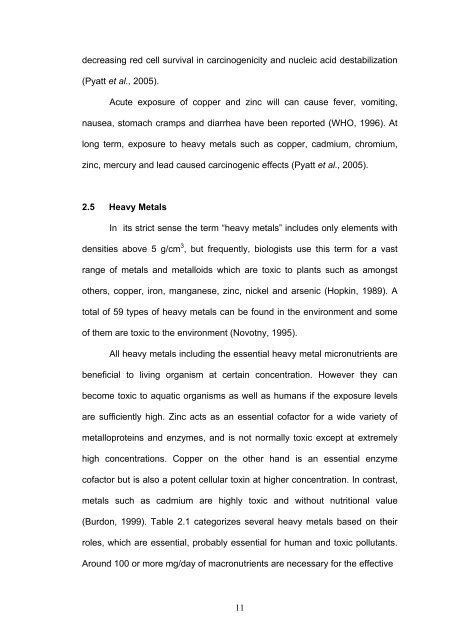IDENTIFICATION OF COPPER-INDUCIBLE GENES IN Pistia stratiotes
IDENTIFICATION OF COPPER-INDUCIBLE GENES IN Pistia stratiotes
IDENTIFICATION OF COPPER-INDUCIBLE GENES IN Pistia stratiotes
You also want an ePaper? Increase the reach of your titles
YUMPU automatically turns print PDFs into web optimized ePapers that Google loves.
decreasing red cell survival in carcinogenicity and nucleic acid destabilization<br />
(Pyatt et al., 2005).<br />
Acute exposure of copper and zinc will can cause fever, vomiting,<br />
nausea, stomach cramps and diarrhea have been reported (WHO, 1996). At<br />
long term, exposure to heavy metals such as copper, cadmium, chromium,<br />
zinc, mercury and lead caused carcinogenic effects (Pyatt et al., 2005).<br />
2.5 Heavy Metals<br />
In its strict sense the term “heavy metals” includes only elements with<br />
densities above 5 g/cm 3 , but frequently, biologists use this term for a vast<br />
range of metals and metalloids which are toxic to plants such as amongst<br />
others, copper, iron, manganese, zinc, nickel and arsenic (Hopkin, 1989). A<br />
total of 59 types of heavy metals can be found in the environment and some<br />
of them are toxic to the environment (Novotny, 1995).<br />
All heavy metals including the essential heavy metal micronutrients are<br />
beneficial to living organism at certain concentration. However they can<br />
become toxic to aquatic organisms as well as humans if the exposure levels<br />
are sufficiently high. Zinc acts as an essential cofactor for a wide variety of<br />
metalloproteins and enzymes, and is not normally toxic except at extremely<br />
high concentrations. Copper on the other hand is an essential enzyme<br />
cofactor but is also a potent cellular toxin at higher concentration. In contrast,<br />
metals such as cadmium are highly toxic and without nutritional value<br />
(Burdon, 1999). Table 2.1 categorizes several heavy metals based on their<br />
roles, which are essential, probably essential for human and toxic pollutants.<br />
Around 100 or more mg/day of macronutrients are necessary for the effective<br />
11








![[Consumer Behaviour] - ePrints@USM](https://img.yumpu.com/21924816/1/184x260/consumer-behaviour-eprintsusm.jpg?quality=85)








